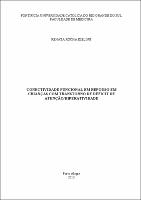| Share record |


|
Please use this identifier to cite or link to this item:
https://tede2.pucrs.br/tede2/handle/tede/1745Full metadata record
| DC Field | Value | Language |
|---|---|---|
| dc.creator | Kieling, Renata Rocha | - |
| dc.creator.Lattes | http://buscatextual.cnpq.br/buscatextual/visualizacv.do?id=K4764647Z8 | por |
| dc.contributor.advisor1 | Franco, Alexandre Rosa | - |
| dc.contributor.advisor1Lattes | http://buscatextual.cnpq.br/buscatextual/visualizacv.do?id=K4706482A5 | por |
| dc.date.accessioned | 2015-04-14T13:35:47Z | - |
| dc.date.available | 2013-09-06 | - |
| dc.date.issued | 2013-08-09 | - |
| dc.identifier.citation | KIELING, Renata Rocha. Conectividade funcional em repouso em crianças com transtorno de déficit de atenção/hiperatividade. 2013. 103 f. Tese (Doutorado em Medicina e Ciências da Saúde) - Pontifícia Universidade Católica do Rio Grande do Sul, Porto Alegre, 2013. | por |
| dc.identifier.uri | http://tede2.pucrs.br/tede2/handle/tede/1745 | - |
| dc.description.resumo | O transtorno de déficit de atenção/hiperatividade (TDAH) é um dos transtornos neuropsiquiátricos mais prevalentes entre crianças. Embora a apresentação clínica e o tratamento do TDAH estejam bem estabelecidos, suas causas ainda não são conhecidas. Técnicas recentes de neuroimagem funcional podem ampliar o conhecimento acerca da fisiopatologia do transtorno, permitindo a testagem empírica de hipóteses conceituais sobre o funcionamento de redes cerebrais no TDAH. Neste trabalho, analisamos um grupo de 23 meninos com diagnóstico de TDAH, com idades entre 8 e 10 anos, virgens de tratamento, que foram submetidos a um protocolo de ressonância funcional de repouso antes e após seis meses de tratamento com metilfenidato. Foram realizadas análises de conectividade funcional entre regiões de interesse (seeds) demarcadas sobre áreas da rede default mode network (DMN). Posteriormente, a conectividade da DMN antes e após o tratamento foi mapeada através de uma análise de componentes independentes (ICA, independent component analysis). Os resultados da análise de seeds não demonstraram modificações significativas na conectividade entre regiões da DMN com o tratamento, havendo apenas um pequeno aumento da conectividade ântero-posterior da rede. A análise por ICA revelou um aumento significativo de conectividade da DMN com o putâmen esquerdo (p<0,01 corrigido). Observou-se ainda uma correlação positiva entre a redução dos sintomas e a conectividade entre o putâmen e a DMN após o tratamento (rho=0,65, p=0,17). Esses achados indicam que o tratamento com metilfenidato modifica a conectividade entre a DMN e núcleos subcorticais. Disfunções em circuitos corticosubcorticais foram frequentemente associados à fisiopatologia do TDAH. O efeito do tratamento com metilfenidato pode, em parte, estar associado à elevação dos níveis dopaminérgicos em núcleos subcorticais, modulando a sua conectividade com a DMN. | por |
| dc.description.abstract | Attention deficit/hyperactivity disorder (ADHD) is one of the most prevalent neuropsychiatric disorders among children. Although the clinical presentation and treatment of ADHD are well established, its etiology is not yet known. Recent functional neuroimaging techniques may help increase knowledge about the pathophysiology of the disorder, allowing for the empirical testing of theoretical hypotheses on brain networks in ADHD. In this study, we analyzed a group of 23 treatment naïve boys with ADHD, aged between 8 and 10 years old, who underwent a protocol of resting-state functional magnetic imaging before and after six months of treatment with methylphenidate. Analyses of functional connectivity were performed between regions of interest (seeds) placed within the default mode network (DMN). Subsequently, changes in the DMN connectivity before and after treatment were investigated with an independent component analysis (ICA). Results of the seeds analysis showed no significant changes in connectivity between regions of the DMN following treatment, with a relatively small increase in the anterior-posterior connectivity of the network. The ICA revealed a significant increase in the connectivity between the left putamen and the DMN (p <0.01, corrected). There was also a positive correlation between the decrease of symptoms and the connectivity between the putamen and the DMN after treatment (rho = 0.65, p = 0.17). These findings indicate that treatment with methylphenidate modifies the connectivity between the DMN and subcortical nuclei. Dysfunctions in corticalsubcortical circuits have often been associated with the pathophysiology of ADHD. The effect of treatment with methylphenidate may in part be associated with elevated dopamine levels in subcortical nuclei, modulating its connectivity with the DMN. | eng |
| dc.description.provenance | Made available in DSpace on 2015-04-14T13:35:47Z (GMT). No. of bitstreams: 1 450585.PDF: 3679647 bytes, checksum: 449520a022e29d4951604d60809e331f (MD5) Previous issue date: 2013-08-09 | eng |
| dc.format | application/pdf | por |
| dc.thumbnail.url | http://tede2.pucrs.br:80/tede2/retrieve/9256/450585.PDF.jpg | * |
| dc.language | por | por |
| dc.publisher | Pontifícia Universidade Católica do Rio Grande do Sul | por |
| dc.publisher.department | Faculdade de Medicina | por |
| dc.publisher.country | BR | por |
| dc.publisher.initials | PUCRS | por |
| dc.publisher.program | Programa de Pós-Graduação em Medicina e Ciências da Saúde | por |
| dc.rights | Acesso Aberto | por |
| dc.subject | MEDICINA | por |
| dc.subject | NEUROCIÊNCIA | por |
| dc.subject | TRANSTORNO DA FALTA DE ATENÇÃO COM HIPERATIVIDADE | por |
| dc.subject | NEUROIMAGEM | por |
| dc.subject.cnpq | CNPQ::CIENCIAS DA SAUDE::MEDICINA | por |
| dc.title | Conectividade funcional em repouso em crianças com transtorno de déficit de atenção/hiperatividade | por |
| dc.type | Tese | por |
| Appears in Collections: | Programa de Pós-Graduação em Medicina e Ciências da Saúde | |
Files in This Item:
| File | Description | Size | Format | |
|---|---|---|---|---|
| 450585.PDF | Texto Completo | 3.59 MB | Adobe PDF |  Download/Open Preview |
Items in DSpace are protected by copyright, with all rights reserved, unless otherwise indicated.




